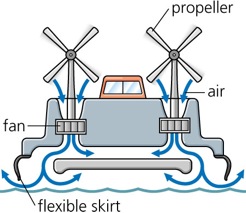 by: Jim Fiddes
by: Jim Fiddes
I recently used this extension of the balloon-CD hovercraft plans in Norm Barstow’s blog for a middle school physical science lab, but it could be easily adapted for a high school IPS class. It works as inquiry for higher-achieving students, but just as well with more detailed direction, for regular classes.
By the time you do this collision addition, your students should be attuned to the fact that “hover” means just that—there is no lateral motion without some sort of propelling force. The hovercraft will just sort of sit there and maybe spin a little. Students looking for more dynamic action will be disappointed. As a mid-point review between the two hovercraft labs, you may show the “Junkyard Wars” episode on hovercraft, in which it’s abundantly clear that hovercraft need two forces—one to levitate the craft, and another to propel it. Students provide the propelling force, accelerating one levitating hovercraft into another, and observing the results.

Illustration: www.xinventions.com
Basically, this addition explores the ideas of Newton’s Three Laws, inertia, momentum (First Law), Newton’s Second Law (force equals mass times acceleration), and even Newton’s Third Law (action-reaction) using collisions between differently-weighted hovercraft. Weighting is done with the simple addition of pennies or washers onto the CD (see below). While it’s difficult to quantify acceleration here, mass can be calculated and compared. If you have a SmartBoard, you can do some cool on-screen demos as lab prep and summary, too! More about this later! The balloon-film canister-CD hovercraft can be constructed as in the blog, using poster putty to attach the film canister to the CD. Hot glue also works to create a more permanent bond, and it avoids the problem of excess putty leaking out through the hole in the CD, which causes friction problems. As a safety/sanitation measure, don’t share balloons between users, and maybe use alcohol wipes to clean out the film canister between classes, since there is some saliva expelled when re-inflating the balloons for multiple trials. Ok, maybe it’s a teachable moment, but be prepared to wipe down the tables with those alcohol wipes, too! One other thing to watch out for–and you can warn students about this, or let them find out for themselves– is that in order for the collisions to happen between the CD’s, the diameter of the balloon inflation cannot exceed the diameter of the CD– when they collide, anyway!
|
Hammacher-Schlemmer has a neat hovercraft for sale, and the two forces needed are fairly apparent, as is the skirt. It costs $19,500, but it’ll do 60 mph! The skirt’s susceptibility to wear and tear being one of the reasons, besides poor fuel economy, that commercial hovercraft didn’t turn out to be as practical as hoped. The point of the skirt to contain the downwards air flow is made clear in the “Junkyard Wars” episode, and you may wish to clarify that with your classes.
Various hovercraft videos are on YouTube, as well. There’s a connection with this lab and bumper cars, which may help students visualize things, and the website Amusement Park Physics, http://www.learner.org/interactives/parkphysics/bumpercars/collision1.html, can help a great deal.
Also, the “Killer Tissue Box” episode of MythBusters helps with the idea of mass, momentum & inertia: http://app.discoveryeducation.com/search?Ntt=killer+tissue+box
In this lab, the balloon provides the levitating force, and students provide the propelling force. The weighting is done with pennies or ¾ inch washers. I used 3 washers (three points make a plane) in a triangular arrangement, but of course you could have the students experiment with different numbers or combinations, and different placements nearer the center or the edge of the CD. Keep track of the washers, or they’ll be found all over the school building. Here’s how I set up the various collisions on the SmartBoard. You could elicit the possible collision types in a pre-lab discussion with receptive classes, as well. Collisions are these: a) un-weighted into un-weighted; b) weighted into un-weighted; c) un-weighted into weighted; and d) weighted into weighted. Notice that the two columns are labeled “accelerating” and “stationary”.  Using the “clone” and “group” functions on the SmartBoard allows you to set this up fairly quickly. I color-coded the various parts: black for CD & film canister, green for poster putty or hot glue, red for balloon, and blue for washers/pennies. With your screen set up this way, you can “scoot” one of the accelerating assemblies over to the other side of the screen with a sweeping motion of your hand touching the screen. This technique will even “bounce” drawn balls off the bottom, and even into baskets you draw! Have fun!
Using the “clone” and “group” functions on the SmartBoard allows you to set this up fairly quickly. I color-coded the various parts: black for CD & film canister, green for poster putty or hot glue, red for balloon, and blue for washers/pennies. With your screen set up this way, you can “scoot” one of the accelerating assemblies over to the other side of the screen with a sweeping motion of your hand touching the screen. This technique will even “bounce” drawn balls off the bottom, and even into baskets you draw! Have fun!
Sample Lab Directions Follow:
Hovercraft Lab – Explorations 2
 Assemble the hovercraft according to directions used previously. Inflate the balloon and prevent the air from escaping by pinching or twisting the balloon neck above where it is attached to the film canister.
Assemble the hovercraft according to directions used previously. Inflate the balloon and prevent the air from escaping by pinching or twisting the balloon neck above where it is attached to the film canister.- Levitate the hovercraft, and gently push it over any smooth surface. Record your observations.
- Allow the hovercraft to hover motionless until the balloon deflates. Record your observations.
- Change the mass of the hovercraft by adding washers or pennies to the CD surface, and then repeat steps above. Experiment with various placements of the penny/washer weights. Record your observations
- Re-inflate and re-levitate, then gently push the weighted hovercraft and notice if the direction and speed (velocity) appears to remain constant or changes before the balloon fully deflates.
- Record your observations on the worksheet in terms of Newton’s laws of motion.
- Remove the extra mass, and gently push one hovercraft towards another levitating but stationary hovercraft. Here it’s un-weighted into un-weighted.
- Record your observations of the collision on the worksheet. Describe the observations in terms of Newton’s laws of motion.
 Change the mass of only the stationary hovercraft using pennies or washers, and repeat steps creating a collision of the two levitating hovercraft. Here, it’s un-weighted colliding into weighted.
Change the mass of only the stationary hovercraft using pennies or washers, and repeat steps creating a collision of the two levitating hovercraft. Here, it’s un-weighted colliding into weighted.- Remove the pennies or washers from the stationary hovercraft, and instead change the mass of the colliding hovercraft, and repeat collision steps with two levitating hovercraft as above. Here it’s weighted colliding into stationary un-weighted.
- Next, collide a weighted hovercraft into another, but stationary, one. Record your observations in terms of Newton’s laws of motion.
- Optional: timed slalom run; arrange 6 or so obstacles on a two-meter course. Time 3 runs. One operator, using one hand only on a levitating hovercraft. o
Jim Fiddes, an ex-Peace Corps Volunteer, is a multi-disciplinary science teacher with 40 years in the classroom, which includes 15 years as an adjunct biology professor at Sacred Heart University in Fairfield, CT. Though he retired from public school teaching in both CT & NY, he couldn’t stand it, and is now doing fill-in positions as he searches for the ultimate retirement gig.
